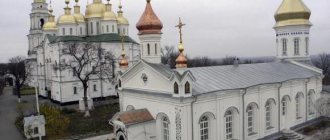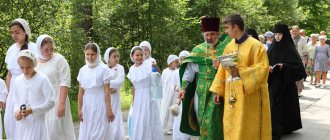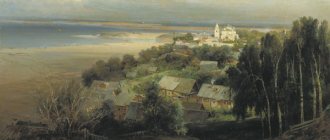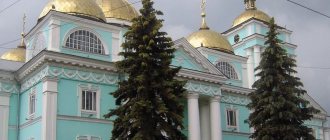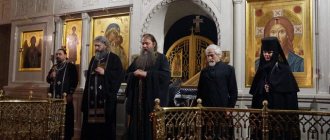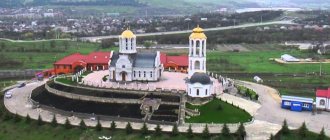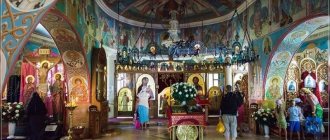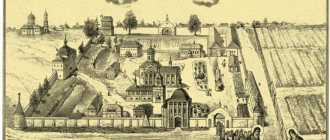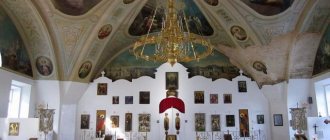Mir
Russia Nizhny Novgorod Region Nizhny Novgorod Holy Cross Convent (Nizhny Novgorod) Map is loading…
{"format":"leaflet","minzoom":false,"maxzoom":false,"limit":50,"offset":0,"link":"all","sort":[""], "order":[],"headers":"show","mainlabel":"","intro":"","outro":"","searchlabel":"\u2026 \u0441\u043b\u0435\ u0434\u0443\u044e\u0449\u0438\u0435 \u0440\u0435\u0437\u0443\u043b\u044c\u0442\u0430\u0442\u044b","default":"","import-annotation":false,"width ":"auto","height":"350px","centre":{"text":"","title":"""link":"""lat":56.30736067000000133475623442791402339935302734375,"lon": 43.9820894100000003845707396976649761199951171875,"icon":""},"title":"","label":"","icon":"","lines":[],"polygons":[],"circles":[ ],"rectangles":[],"copycoords":false,"static":false,"zoom":8,"defzoom":14,"layers":["OpenStreetMap"],"image layers":[] ,"overlays":[],"resizable":false,"fullscreen":true,"scrollwheelzoom":true,"cluster":false,"clustermaxzoom":9,"clusterzoomonclick":true,"clustermaxradius":80, "clusterspiderfy":true,"geojson":"","clicktarget":"","showtitle":true,"hidenamespace":false,"template":"","userparam":"","activeicon": "","pagelabel":false,"ajaxcoordproperty":"","ajaxquery":"","locations":[{"text":"\u003Cb\u003E\u003Ca href=\"/palomnik/%D0% 9A%D1%80%D0%B5%D1%81%D1%82%D0%BE%D0%B2%D0%BE%D0%B7%D0%B4%D0%B2%D0%B8%D0%B6% D0%B5%D0%BD%D1%81%D0%BA%D0%B8%D0%B9_%D0%B6%D0%B5%D0%BD%D1%81%D0%BA%D0%B8%D0% B9_%D0%BC%D0%BE%D0%BD%D0%B0%D1%81%D1%82%D1%8B%D1%80%D1%8C_(%D0%9D%D0%B8%D0%B6 %D0%BD%D0%B8%D0%B9_%D0%9D%D0%BE%D0%B2%D0%B3%D0%BE%D1%80%D0%BE%D0%B4)\» title=\ »\u041a\u0440\u0435\u0441\u0442\u043e\u0432\u043e\u0437\u0434\u0432\u0438\u0436\u0435\u043d\u0441\u043a\u0438\u0439 \u0436\ u0435\u043d\u0441\u043a\ u0438\u0439 \u043c\u043e\u043d\u0430\u0441\u0442\u044b\u0440\u044c (\u041d\u0438\u0436\u043d\u0438\u0439 \u041d\u043e\u0432\u 0433\u043e\u0440\u043e\u0434 )\u003E\u041a\u0440\u0435\u0441\u0442\u043e\u0432\u043e\u0437\u0434\u0432\u0438\u0436\u0435\u043d\u0441\u043a\u0438\u0439 \u0436\u0435\u043d\ u0441\u043a\u0438\u0439 \u043c\u043e\u043d\u0430\u0441\u0442\u044b\u0440\u044c (\u041d\u0438\u0436\u043d\u0438\u0439 \u041d\u 043e\u0432\u0433\u043e\u0440 \u043e\u0434)\u003C/a\u003E\u003C/b\u003E\u003Chr /\u003E\u003Ca href=\"/palomnik/%D0%A1%D0%B2%D0%BE%D0%B9%D1% 81%D1%82%D0%B2%D0%BE:%D0%90%D0%BD%D0%BD%D0%BE%D1%82%D0%B0%D1%86%D0%B8%D1%8F \" title=\"\u0421\u0432\u043e\u0439\u0441\u0442\u0432\u043e:\u0410\u043d\u043d\u043e\u0442\u0430\u0446\u0438\u044f\"\u003E\u0410 \u043d\ u043d\u043e\u0442\u0430\u0446\u0438\u044f\u003C/a\u003E: "'\u041a\u0440\u0435\u0441\u0442\u043e\u0432\u043e\u0437\u0434\u043 2\u0438\u0436\u0435 \u043d\u0441\u043a\u0438\u0439 \u043c\u043e\u043d\u0430\u0441\u0442\u044b\u0440\u044c»' \u043e\u0441\u043d\u043e\u0432\u043 0\u043d\u0432\u043e\u0432 XIV \u0432\u0435\u043a\u0430","title":"\u041a\u044 0\u0435\u0441 \u0442\u043e\u0432\u043e\u0437\u0434\u0432\u0438\u0436\u0435\u043d\u0441\u043a\u0438\u0439 \u0436\u0435\u043d\u0441\u043a\u 0438\u0439\u043c\u043e\u043d \u0430\u0441\u0442\u044b\u0440\u044c (\u041d\u0438\u0436\u043d\u0438\u0439 \u041d\u043e\u0432\u0433\u043e\u0440\u043e\u0434) ""link":"" ,"lat":56.30736067000000133475623442791402339935302734375,"lon":43.9820894100000003845707396976649761199951171875,"icon":""}],"imageLa yers":[]}
56.307302; 43.982046
Russia, Nizhny Novgorod, Oksky Congress, 2B
Nizhny Novgorod, Nizhny Novgorod region
Russia
Telephone.:
8 (831) 433-92-25, 433-76-85 (accounting)
Holy Cross Monastery
founded in the second half of the 14th century.
Belongs to the Nizhny Novgorod and Arzamas diocese of the Russian Orthodox Church. The Holy Cross Convent in Nizhny Novgorod should not be confused with the Holy Cross Convent in the village of Krasnye Mary, Nizhny Novgorod Region.
Patronal feast day - September 27 (Exaltation of the Life-Giving Cross of the Lord).
History[[edit]h2>
Between 1355 and 1365, the wife of the Nizhny Novgorod-Suzdal Prince Andrei Konstantinovich Anastasia (in monasticism - Vassa, in the schema - Theodora) founded the Conception Monastery at the foot of the Nizhny Novgorod Kremlin. After the defeat of Novgorod in 1478 by Ivan III, the Novgorod mayor Martha Boretskaya was forcibly tonsured a nun in the monastery.
In the fires of 1685 and 1715, the old wooden monastery burned out “without a trace,” and the springs gushing from under the mountain constantly destroyed the buildings. Therefore, in the middle of the 18th century, Bishop Dimitri (Sechenov) transferred the nuns to the Origin Convent, which stood above the cliff of the Dyatlov Mountains between the St. George Tower of the Kremlin and the church of the same name. Bishop Pitirim of Nizhny Novgorod transferred the community there from the burnt Resurrection Monastery, located near the St. Nicholas Tower of the Kremlin. As a result, during the church reform of 1764, all three Nizhny Novgorod convents (Zachatievsky, Resurrection and Proiskhoddensky) were united into one monastery.
In 1814, after another fire, the monastery was moved to the Arzamas outpost (present-day Lyadov Square) and renamed Holy Cross. In the same year, the walls of the monastery, a bell tower with the Holy Gates, two tents next to them, eight buildings, and a guest courtyard outside the walls of the monastery were erected. In 1814-1823 the Cathedral of the Exaltation of the Cross was built (rebuilt in 1848). In 1815, the hospital’s Sorrow Church was consecrated next to one of the buildings. In 1838, a school for girls was opened at the monastery.
Before the revolution, every year on Saturday of Bright Week there was a religious procession from the Oran Monastery to the Holy Cross Monastery with the Oran Vladimir Icon of the Mother of God, one of the most revered in Nizhny Novgorod. The monastery was considered a place of penance for women who had committed crimes against morality.
In 1848, the Holy Cross Monastery was enrolled in class I with an increase in staff from 30 to 100 people.
At the end of the 19th century, one schema-nun, 30 nuns and 149 novices lived in the monastery. There was a gold embroidery workshop in which about 55 sisters embroidered priestly vestments, vestments for icons and shrouds, and worked with pearls and foil. In 1906, a painting school began operating in the monastery.
The monastery was abolished in 1917. By January 1928, all nuns were evicted from the territory of the monastery. The community moved to the Kazan Cemetery Church. On Bright Week 1935, members of the clergy of the Kazan Church and Metropolitan Evgeniy (Zernov) of Gorky and Arzamas were arrested. On August 19, 1935, the Commission on Cults under the Presidium of the Gorky Regional Executive Committee decided: the former Holy Cross Monastery should be liquidated for demolition. In Soviet times, its buildings housed warehouses, living quarters, and offices; The cathedral housed a razor factory.
In the 1950s, the monastery ensemble, which miraculously survived, was closed from Lyadov Square by a five-story building of the Polytechnic Institute dormitory. Part of the cemetery territory was built up, and part was given over to a sports ground. The surviving buildings of the monastery were occupied by various institutions, which often changed each other, and were also rented out to residents. Until recently, the monastery buildings were mainly used by the machine-building plant named after. Ya.M. Sverdlova and SKTU "Logos".
Lyadov Square
If your tourist route has led you to the Holy Cross Convent
, then be sure to pay attention to Lyadov Square, which is impossible to pass by. It also has its own attractions.
Lyadov Square and the Oka congress going down from it
By the way, this square was previously called Krestovozdvizhenskaya
, named after the monastery located here.
Later the square was called Monastyrskaya
, and then
Lyadova
, in honor of a party leader. From Krestovozdvizhenskaya Square there was the Arzamas Highway, on one side of which there was a military camp, and on the other, the Kazan Cemetery.
Krestovozdvizhenskaya Square near the monastery at the end of the 19th century
On this square in the 80s. 19th century
the famous Nizhny Novgorod businessman and philanthropist
N. Bugrov
erected a three-story red brick
Widow's House
(architect N. Frelikh). This most substantial shelter was intended for free accommodation of low-income widows and orphans of former government employees, of whom there were about 500-600 people on full board.
Widow's house on Monastery Square at the end of the 19th century
The founders of the shelter knew the fate of each resident and helped as best they could. Street orphans also settled here and received clothing, shelter and food, as well as some education. Moreover, having become adults, they could get a job with Burgov, and if they wanted to go their own way, they received a small financial assistance for the first time. A receiver cradle was equipped for foundling children. These children were also put on their feet in the Widow's House.
It is interesting that the future famous revolutionary Pyotr Zalomov
, which is the prototype of the main character of Gorky’s
novel “Mother”
- Pavel Vlasov. After coming of age, leaving the walls of the Widow's House, Peter works at the Sormovsky plant on the Nizhny Novgorod Strelka, where he embarks on the path of revolutionary struggle against the oppressors.
Today, the former Widow's House is inhabited by students of the city Technical University.
In 2010
a monument to N. Burgov
in the form of a bust was erected
Monument to N. Bugrov near the former Widow's House
And the following year, the Monument to the Exaltation of the Cross
with Queen Helena, Patriarch Macarius and the Life-Giving Cross.
Monument to the Exaltation of the Cross
This monument today is an excellent landmark for the location of the Holy Cross Monastery.
For other temples in Nizhny Novgorod, see Temples of Nizhny Novgorod
Author of the article: Kasatkina Tatyana
Current state[[edit]h2>
The Holy Cross Cathedral has been restored since 1995. On March 25, 2004, by decision of the Holy Synod, the parish of the cathedral was again transformed into the Holy Cross Convent. On August 18, 2004, the nun of the Holy Trinity Seraphim-Diveevsky Monastery Tatiana (Gazhu) was appointed the abbot of the monastery. On September 26, 2005, the senior priest of the monastery Nikolai (Alyasov) performed the rite of consecration of the belfry. 8 bells, the largest of which weighs 600 kg, were cast with funds from philanthropists in the city of Kasli. The bells were installed on a temporary belfry; Abbot Tikhon (Zatekin) struck them first.
On April 25, 2006, with the blessing of Patriarch Alexy II, nun Philareta (Gazhu) was appointed abbess of the monastery.
On December 1, 2007, Archbishop Georgy of Nizhny Novgorod and Arzamas consecrated the chapel in honor of the Iveron Icon of the Mother of God, located in the basement of the cathedral.
On December 17, 2008, in the lower chapel in honor of the Iveron Icon of the Mother of God, the first tonsure was performed after the closure of the monastery in 1917.
On March 7, 2010, Archbishop Georgy of Nizhny Novgorod and Arzamas together with Archbishop Jonathan of Tulchin and Bratslav celebrated the Divine Liturgy. The day before the liturgy, two more nuns of the monastery took monastic vows.
On September 27, 2011, on the day of the holiday in honor of the Exaltation of the Precious and Life-Giving Cross of the Lord, Archbishop George performed the rite of the Great Consecration of the Cathedral of the Exaltation of the Cross. A week before the holiday, artists from the “Ark” icon-painting workshop completed painting in the western part of the cathedral. In total, the painting of the cathedral took more than two years. Only a few fragments have survived from the old painting: the composition “The Exaltation of the Cross of the Lord”, images of St. Nicholas the Wonderworker and Archangel Michael. When restoring the paintings, surviving photographs of the southern and northern vaults were used.
On November 22, Archbishop Georgy of Nizhny Novgorod and Arzamas, co-served by the vicar of the Saransk diocese, Bishop Ruzaevsky Elijah (Bykov), consecrated the right side chapel of the Cathedral of the Exaltation of the Cross in honor of the Praise of the Most Holy Theotokos and the Hieromartyr Dionysius the Areopagite. On December 30, in honor of the Entry into the Temple of the Most Holy Theotokos, St. Innocent of Irkutsk and Hieromartyr Demetrius of Thessaloniki, the left side chapel of the Cathedral of the Exaltation of the Cross was consecrated.
The monastery operates a Sunday school and an Orthodox medical center. The closest surviving parish church is Resurrection Church, located 700 meters from the monastery.
Story
The first mentions of the Holy Cross Monastery date back to the second half of the 18th century, but its prehistory goes back centuries. The history of the Holy Cross monastic community began on the banks of the great Volga River near the walls of the Nizhny Novgorod Kremlin.
Holy Cross Monastery, Nizhny Novgorod
Conception Monastery
On the Volga bank at the foot of the Kremlin hill in the area of the Conception Tower, the Conception Monastery appeared in the middle of the 14th century. It was erected according to a vow made by Princess Anastasia Ivanovna to the Mother of God. The princess asked the Heavenly Intercessor for the gift of children, but during the years of marriage she never knew the happiness of motherhood. After the death of her husband, Anastasia took monastic vows and, under the name of Theodora, spent the rest of her earthly journey in the monastery she founded.
For four centuries, despite the fires that many times destroyed the monastery buildings, it flourished. Its cathedral church was considered one of the most richly decorated cathedrals in the city. During a fire that broke out on the territory of the Kremlin in 1743, all the monastery buildings were completely burned and could not be restored. Nizhny Novgorod Bishop Dimitri ordered the territory near the monastery of the Origin of the Honest Trees of the Holy Cross to be transferred to the Conception nuns.
Here the nuns erected several buildings, enclosing them with a low fence. They submitted a petition several times to restore the Conception monastery in its original location, but in 1764 about 100 nuns and all their property became part of the Origin Monastery.
Interesting: for a short period of independent existence of the Zachatievskaya monastic community near the St. George Tower of the Kremlin, in some documents it was called St. George.
Resurrection Monastery
At the beginning of the 17th century, the Resurrection Monastery appeared near the southern wall of the Nizhny Novgorod Kremlin in the area of the Nikolskaya Tower. Only about 10 nuns lived in it. The monastery was in charge of several wooden buildings, which were destroyed by fire at the beginning of the 18th century. By this time, seven elderly nuns lived in them, who, along with the monastery property, were assigned to the Origin Convent.
Origin Monastery
The formation of this monastery coincided with the formation of the people's militia in Nizhny Novgorod. Since 1612, there was a church here in honor of the Origin of the Honest Trees of the Holy Cross, which burned down at the beginning of the 18th century. In 1715, a new temple was erected in its place, consecrated in June 1716 in honor of the Exaltation of the Precious and Life-Giving Cross of the Lord.
Cathedral of the Exaltation of the Holy Cross (main entrance)
The renewed monastery received the name Holy Cross Monastery. For 50 years, it, together with the cells of the Conception nuns, was located near the St. George Tower. In 1764, the third-class Holy Cross Monastery united three women's monasteries located outside the walls of the Kremlin.
Monastic community on the banks of the Oka
Changes in the life of the Holy Cross Monastery began from the time when Abbess Dorothea took over its leadership. In 1807, a strict communal charter was introduced into the monastic community with strict subordination of junior nuns to senior sisters. The commitment of the female monastic community to an ascetic life dedicated to serving God and righteous work led to an increase in the class of the monastery.
In 1812, the abbess petitioned the Nizhny Novgorod ruler to move the monastery from the Kremlin territory. The petition stated the following reasons:
- due to the increase in the number of nuns, expansion of living quarters is required;
- dilapidation of monastery buildings due to time and adverse effects of external factors;
- the danger of significant damage and loss of monastery property due to frequent fires.
Dorothea’s request was approved by both ecclesiastical and secular authorities, allocating empty lands to the monastery not far from the Arzamas outpost near the Kazan cemetery church. By the fall of 1814, the following buildings appeared on the monastery territory:
- exterior walls;
- stone buildings;
- belfry;
- hospital church in honor of the icon of the Mother of God “Joy of All Who Sorrow” and St. Basil;
- foundation of the main cathedral.
Historical photo of the monastery at the beginning of the twentieth century
The Cathedral of the Exaltation of the Cross was consecrated in 1823. It was a cruciform building measuring 35*35 meters. It was decorated with five gilded domes that stood on large light drums. The walls were built of red brick and covered with plaster. Stone monastery buildings were placed around the cathedral in the form of a square and connected by wooden galleries. The territory was enclosed by a stone fence with corner towers. Above the main western gate is a 34-meter-high bell tower, on which there was a belfry with seven bells.
A quarter of a century later, the roof of the cathedral was rebuilt, replacing the ceilings with vaults. During this reconstruction, the main iconostasis was replaced and some of the icons were updated. According to the descriptions of contemporaries, at this time a large garden and new higher walls appeared in the Holy Cross Monastery. In 1854, under the altar of the main temple, a church was built in the name of the Iveron Icon of the Mother of God, in which the tomb of the abbess was located.
By the beginning of the 20th century, the monastic community at the Arzamas outpost was famous both in the city and beyond. Her nuns became abbess of female monastic communities in many Russian provinces. The products of the monastery gold-embroidery workshop and painting school were also widely known.
Soviet time
The Bolsheviks closed the Holy Cross Convent in Nizhny Novgorod in 1918. This was preceded by the confiscation of valuables, during which a clash occurred between nuns, parishioners and an armed detachment, which ended in the death of two people. For ten years, the monastic community rented the cathedral church and part of the monastery buildings.
In 1928, the nuns were finally expelled from the territory of the community, where a military unit was organized. After this, the parish and monastic community held services in the Kazan cemetery church. In 1935, the holiday of Easter Sunday coincided with the Soviet proletarian holiday, which took place on May 1. The city leadership considered that holding a service on this day distracted the townspeople from an important holiday. This served as a reason for the arrest of Gorky and Arzamas Metropolitan Evgeniy and several other city clergy.
The Kazan Church was closed, and in August they decided to demolish the Church of the Exaltation of the Cross and the surrounding buildings. It is not known exactly why this order was not carried out; almost all the monastery buildings survived the Soviet years. Various organizations, communal apartments, utility rooms and the production of razor products were located here.
Interesting: according to legend, the security officers tried three times to blow up the monastery buildings, but each time Abbess Dorothea appeared to them, threatening the wicked with terrible punishments.
Recovery
In the mid-90s of the last century, the completely worn-out buildings of the former Holy Cross monastery were transferred by the city authorities to the Nizhny Novgorod diocese. They immediately began to restore the cathedral church, which was filled with garbage and waste from electroplating production. In 1997, a small church in the name of the Holy New Martyr Elizabeth was consecrated in the restored monastery building. Until the consecration of the Main Temple, divine services were held in it, and after that wedding and baptism ceremonies were held there.
Interior of the Holy Cross Cathedral
Monastic life resumed at the monastery in 2004. The community was headed by nun Tatiana, who labored in the Diveyevo Monastery. Two years later, she took monastic vows under the name Philaret and accepted the position of abbess.
In 2006, during the clearing of the basement room, which was carried out with the aim of restoring the Iverskaya Church, builders found the remains of the abbess of the Exaltation of the Cross. Among them, the incorrupt relics of Abbess Dorothea I were discovered. In December, they were all honorably reburied in the renovated church.
Shrines of the monastery
Within the walls of the Church of the Exaltation of the Cross there are many shrines that are close to the heart of any Orthodox Christian.
First of all, the ark with a particle of the relics of St. Andrew the First-Called Apostle, the shrine with a particle of the tree of the Life-Giving Cross - a gift from Metropolitan George.
Among the icons here are especially revered and valuable: the Kazan Mother of God, the “Goalkeeper” or the Iveron Mother of God - the intercessor of all monastics, the icon containing the relics of the Great Martyr George the Victorious.
How to get to the monastery
The monastery is located in the Nizhny Novgorod region, on Oksky Congress Street, 2.
By car. Along the Moskovskoye Highway you need to cross the Metrobridge to Barminskaya Street. Then at the second traffic light turn left onto Krupskaya Street, drive straight along it and turn right onto the street. Ilyinskaya, which will lead to the territory of the monastery.
Monastery bell tower
On public transport. You can get to the monastery by tram (stops “Krasnoselskaya Street” and “Malaya Yamskaya Street”), as well as buses and minibuses (stops “Oksky Congress” and “Lyadova Square”). It is not difficult to walk from the Gorkovskaya metro station to the monastery in 15 minutes (about 1 km).
Attraction rating:
Rating 4.33 [3[3 Votes]p>
| ← N.NOVGOROD | NIZHNY NOVGOROD REGION MONASTERIES OF N. NOVGOROD | RUSSIA → |

